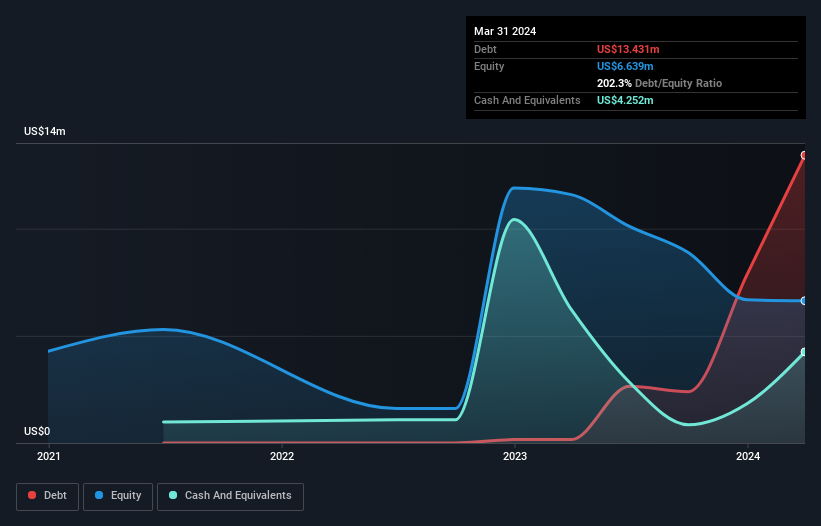
The external fund manager backed by Berkshire Hathaway's Charlie Munger, Li Lu, makes no bones about it when he says 'The biggest investment risk is not the volatility of prices, but whether you will suffer a permanent loss of capital.' So it seems the smart money knows that debt - which is usually involved in bankruptcies - is a very important factor, when you assess how risky a company is. We note that Moolec Science SA (NASDAQ:MLEC) does have debt on its balance sheet. But the more important question is: how much risk is that debt creating?
When Is Debt Dangerous?
Debt and other liabilities become risky for a business when it cannot easily fulfill those obligations, either with free cash flow or by raising capital at an attractive price. Ultimately, if the company can't fulfill its legal obligations to repay debt, shareholders could walk away with nothing. While that is not too common, we often do see indebted companies permanently diluting shareholders because lenders force them to raise capital at a distressed price. Of course, debt can be an important tool in businesses, particularly capital heavy businesses. The first step when considering a company's debt levels is to consider its cash and debt together.
See our latest analysis for Moolec Science
How Much Debt Does Moolec Science Carry?
As you can see below, at the end of March 2024, Moolec Science had US$13.4m of debt, up from US$160.0k a year ago. Click the image for more detail. On the flip side, it has US$4.25m in cash leading to net debt of about US$9.18m.

A Look At Moolec Science's Liabilities
According to the last reported balance sheet, Moolec Science had liabilities of US$7.82m due within 12 months, and liabilities of US$11.5m due beyond 12 months. Offsetting these obligations, it had cash of US$4.25m as well as receivables valued at US$1.74m due within 12 months. So its liabilities total US$13.3m more than the combination of its cash and short-term receivables.
This deficit isn't so bad because Moolec Science is worth US$34.4m, and thus could probably raise enough capital to shore up its balance sheet, if the need arose. However, it is still worthwhile taking a close look at its ability to pay off debt. The balance sheet is clearly the area to focus on when you are analysing debt. But ultimately the future profitability of the business will decide if Moolec Science can strengthen its balance sheet over time. So if you're focused on the future you can check out this free report showing analyst profit forecasts.
While it hasn't made a profit, at least Moolec Science booked its first revenue as a publicly listed company, in the last twelve months.
Caveat Emptor
Over the last twelve months Moolec Science produced an earnings before interest and tax (EBIT) loss. Indeed, it lost a very considerable US$10m at the EBIT level. When we look at that and recall the liabilities on its balance sheet, relative to cash, it seems unwise to us for the company to have any debt. So we think its balance sheet is a little strained, though not beyond repair. However, it doesn't help that it burned through US$11m of cash over the last year. So in short it's a really risky stock. When analysing debt levels, the balance sheet is the obvious place to start. However, not all investment risk resides within the balance sheet - far from it. For example, we've discovered 4 warning signs for Moolec Science (2 don't sit too well with us!) that you should be aware of before investing here.
Of course, if you're the type of investor who prefers buying stocks without the burden of debt, then don't hesitate to discover our exclusive list of net cash growth stocks, today.
New: Manage All Your Stock Portfolios in One Place
We've created the ultimate portfolio companion for stock investors, and it's free.
• Connect an unlimited number of Portfolios and see your total in one currency
• Be alerted to new Warning Signs or Risks via email or mobile
• Track the Fair Value of your stocks
Have feedback on this article? Concerned about the content? Get in touch with us directly. Alternatively, email editorial-team (at) simplywallst.com.
This article by Simply Wall St is general in nature. We provide commentary based on historical data and analyst forecasts only using an unbiased methodology and our articles are not intended to be financial advice. It does not constitute a recommendation to buy or sell any stock, and does not take account of your objectives, or your financial situation. We aim to bring you long-term focused analysis driven by fundamental data. Note that our analysis may not factor in the latest price-sensitive company announcements or qualitative material. Simply Wall St has no position in any stocks mentioned.
Have feedback on this article? Concerned about the content? Get in touch with us directly. Alternatively, email editorial-team@simplywallst.com
About NasdaqCM:MLEC
Moolec Science
A science-based food ingredient company, focuses on developing ingredients for food, pet food, animal feed, and dietary supplements using molecular farming technology.
Slight with worrying balance sheet.
Similar Companies
Market Insights
Community Narratives



